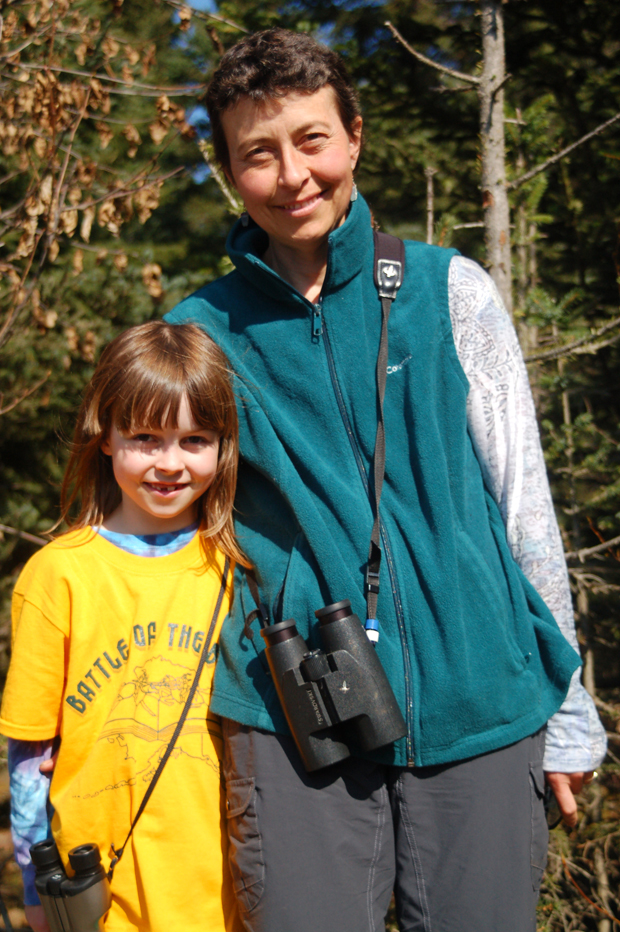Getting started in birding can be intimidating. When experienced birders show up this week for the 22nd annual Kachemak Bay Shorebird Festival, with all their binoculars, spotting scopes, outdoor gear, bird guides and gadgets, the new birder might wonder if it takes a small fortune to get started. The festival starts today with bird tours, talks and the first shorebird viewing station at 10 a.m. at Mud Bay and Lighthouse Village on the Homer Spit.
Consider, for example, keynote speaker Bill Thompson III’s gear list on his blog: Zeiss Victory FL 8×42 binoculars, Leica Televid 85mm with 15–50x zoom eyepiece spotting scope, a Bogen Manfrotto 055CX3 carbon fiber tripod with Bogen 3130 Micro-fluid style pan head, Dorfman Pacific Company field hat, MuckBoot Company Wetlands insulated rubber boots, the Peterson “Field Guide to the Birds of North America,” the Sibley “Guide to Birds of North America” and Thompson’s “The Young Birder’s Guide to Birds of Eastern North America.” Whew.
While all of that can make birding more enjoyable, the new birder can get started with a few basics. Junior birder Eryn Field, 8, and her mom, Carmen Field, said the best way to get started is to watch birds and hang out with experienced birders — something people can do often this weekend.
“You study them,” Eryn said. “Also, you just kind of be around people who know a lot about birds, because they will teach you a lot.”
For this year’s shorebird festival, Eryn will spend her seventh year in the Junior Birder program. The Junior Birder program introduces kids to birding, with more and more challenges each year to get a Junior Birder Badge. This year, for example, Eryn will do a citizen-science trip with George Matz and learn about the Kachemak Bay Birders shorebird monitoring program.
For gear, the Fields recommend some basic equipment: a good pair of binoculars and a good field guide.
Ben Lizdas of Eagle Optics presents a talk, “Birding Optics 101,” at 10 a.m. Friday at the Alaska Islands and Ocean Visitor Center, with tips about what to look for in binoculars and spotting scopes.
Carmen Field suggested a pair of 7×42 or 8×42 binoculars. The first number is the magnification and the second number is the size of the lens bringing in the light, with the larger the number the brighter the binocular. That gives a nice wide field of vision, she said.
She suggested two books, Robert Armstrong’s “Birds of Alaska,” which narrows things down a bit, and the National Geographic “Field Guide to the Birds of North America.” Another popular guide is David Sibley’s “Sibley Guide to the Birds of North America.” Carmen Field prefers the National Geographic guide.
“It’s easy to find things,” she said. “I like the illustrations in National Geographic.”
Another way to learn about birds is to listen for them, Eryn said.
“You look at the bird and then you figure out what sound matches what bird,” she said. “That will stick with you.”
Some bird songs can be easy to remember, like that of the golden crowned sparrow. Some people say it sings “oh dear me” while Alaska homesteaders say the bird sings “you damn fool.” Another memorable bird song is the varied thrush, one of the first spring birds, with its distinctive old-fashioned telephone ring sound.
Eryn said her favorite bird sound is that of the yellowlegs, one of the first shorebirds to arrive in Kachemak Bay. It makes a cheet-cheet-cheet call when it’s alarmed.
“That’s a cool sound,” Eryn said.
Carmen and her husband Conrad Field are both experienced naturalists, and have guided around the world, including Antarctica. Eryn went on one trip there with her parents. The coolest birds she’s ever seen she saw on that trip: albatrosses and penguins. The neatest bird in Alaska she’s seen is the rock ptarmigan, spotted on a trip last summer on a hike in the mountains above Hope.
“It has a very distinctive look and it’s really cool to look at,” Eryn said.
Her favorite bird in Kachemak Bay is the shoveler duck.
“They’re fun to watch,” she said.
What’s fun about birding is you can see birds anywhere, Eryn said.
“You’re guaranteed to see birds at the beach,” Carmen Field said, like seagulls, crows and bald eagles.
Once people get started watching birds, it can become a lifelong enjoyment, a reason to keep birding and getting to know more experienced birders, Eryn said.
“It’s just that they have been around birds their whole life and they’re always looking for new ones,” she said of birders. “They’ve made a relationship with birds.”
People also get excited about birds when they see them up close, either in person or with the help of good optics, Carmen Field said.
“The difference between a bird 500 feet away and 50 feet away is huge,” she said. “That’s where binoculars and spotting scopes come in handy. They can bring things closer.”
Part of the attraction of the shorebird festival is seeing thousands of birds swirling around in great flocks, like a moving sculpture that changes colors as the birds turn their wings.
“It’s like a slinky, almost,” Eryn said. “They go bounce, bounce, bounce. They go back and forth. It’s like a wave.”
Birding also can link people to nature and the changes over the year.
“Birds are harbingers of the season,” Carmen Field said. “For me the spring harbingers are the varied thrush and the sandhill cranes and the snipes and the yellowlegs and the terns and swallows.”
Most of all, birding is amazing, Eryn said.
“Just every part of it is magical,” she said. “The birds, the people you’re around with. It all comes together. It’s awesome.”


